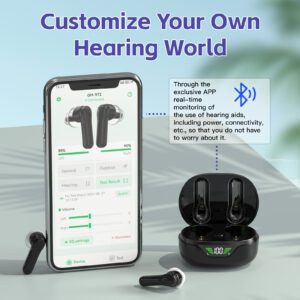Tinnitus, a condition characterized by a persistent ringing, buzzing, or hissing sound in the ears, affects millions globally. For wholesale buyers and distributors in the hearing aid industry, understanding the best solutions for tinnitus is essential, as it represents a significant portion of the market. This article will offer key insights into selecting the best hearing aids for tinnitus, tailored to meet the needs of wholesale buyers who serve a wide range of customers.
What is the Best Hearing Aid for Tinnitus?
When sourcing hearing aids designed specifically for tinnitus, the key is to focus on models that incorporate advanced tinnitus masking technology. Hearing aids equipped with sound therapy or noise generation capabilities are typically the most effective options for alleviating tinnitus symptoms. These features help to mask the internal sounds caused by tinnitus while simultaneously improving the hearing experience for the user.
Choosing the right hearing aid for tinnitus involves considering various factors, including technology integration, comfort, and the ability to offer a customizable solution for different customer needs. Let’s explore what makes these devices stand out in the marketplace.
How Do Hearing Aids Help with Tinnitus?
For wholesale distributors, it’s important to understand the mechanisms by which hearing aids address tinnitus. Hearing aids work by amplifying external sounds, which can help divert attention away from the internal ringing or buzzing. Moreover, certain models are equipped with specialized tinnitus relief features, including:
- Sound Therapy: These hearing aids play soothing sounds, such as nature sounds or white noise, which effectively mask the tinnitus sounds.
- Tinnitus Maskers: Low-level sound emitters that provide a counterbalance to the frequency of tinnitus, offering relief from the constant noise.
- Noise Generators: These are designed to reduce the perception of tinnitus by providing external auditory stimulation.
- Customizable Settings: Many hearing aids offer adjustable features that cater to the unique needs of each tinnitus sufferer.
For wholesale buyers, offering hearing aids with these advanced features ensures that you can cater to a wide variety of customers and address their specific needs for tinnitus management.
What Features Should Be Prioritized in Hearing Aids for Tinnitus?
When sourcing hearing aids for tinnitus sufferers, it’s crucial to focus on the following features that contribute to both comfort and effectiveness:
1. Tinnitus Masking Technology
Hearing aids with built-in tinnitus masking capabilities are essential. These models provide relief by emitting soothing sounds or white noise that help mask the tinnitus. As a wholesaler, partnering with manufacturers that offer a variety of masking sound options will give your customers more flexibility in choosing the best solution for their needs.
2. Customizable Sound Settings
Customization is key when it comes to tinnitus relief. Hearing aids that allow users to adjust the volume of the masking sound or select different sound therapies offer a significant advantage. This flexibility enhances the appeal of your offerings, ensuring that you can meet a wider range of customer preferences.
3. Advanced Noise Cancellation
For tinnitus sufferers, background noise can exacerbate the condition. Hearing aids with strong noise cancellation capabilities provide an enhanced listening experience by reducing environmental noise. This feature is particularly valuable for customers seeking a high level of clarity and comfort, especially in noisy environments.
4. Comfort and Fit
Since hearing aids are often worn for long periods, comfort and fit are paramount. Models that offer a variety of sizes and styles, including behind-the-ear (BTE) and in-the-ear (ITE) options, ensure that you can meet the demands of different customers. Comfort can be a key selling point for your clients, especially those dealing with long-term tinnitus.
5. Bluetooth Connectivity
Bluetooth-enabled hearing aids are increasingly in demand, as they allow users to connect their devices to smartphones, tablets, or other Bluetooth-enabled gadgets. This feature is valuable for users who wish to stream sound therapy directly into their hearing aids, making it an important selling point for wholesalers catering to tech-savvy consumers.
What Types of Hearing Aids Are Best for Tinnitus?
Wholesale buyers should focus on offering a variety of hearing aid styles to suit different customer preferences and levels of tinnitus severity. Here are the main types of hearing aids that are best for managing tinnitus:
1. Behind-the-Ear (BTE) Hearing Aids
BTE hearing aids are worn behind the ear and are ideal for customers with severe tinnitus or more significant hearing loss. These models often feature more advanced tinnitus management capabilities due to their larger design, allowing for more powerful processors and sound therapy integration.
2. In-the-Ear (ITE) Hearing Aids
ITE hearing aids sit within the ear canal and offer a more discreet option for those with mild to moderate tinnitus. They are easy to use and comfortable, making them a popular choice among customers who prefer a less visible device.
3. Invisible in the Canal (IIC) Hearing Aids
IIC hearing aids are the most discreet option, sitting deep within the ear canal. Their small size makes them virtually invisible, and they are an excellent choice for customers who prioritize aesthetics without sacrificing the efficacy of tinnitus relief.
4. Receiver-in-Canal (RIC) Hearing Aids
RIC hearing aids combine the best aspects of BTE and ITE models. They provide high-quality sound amplification while maintaining a discreet appearance. These devices are ideal for tinnitus sufferers who need a blend of powerful performance and discreet wearability.
What Are the Best Hearing Aid Brands for Tinnitus?
As a wholesale buyer, it’s important to offer hearing aids from reputable brands that specialize in tinnitus relief. Here are a few leading brands known for their advanced tinnitus management solutions:
1. Phonak
Phonak offers hearing aids with Tinnitus Balance technology, which provides tailored sound therapy for tinnitus sufferers. Their models are highly regarded for both performance and comfort, making them a reliable choice for your customers.
2. Starkey
Starkey’s Livio AI hearing aids incorporate advanced tinnitus relief features, such as masking sounds and personalized sound therapy. Their devices also offer health-tracking capabilities, which is an added benefit for customers seeking a multi-functional solution.
3. Goodmi
Goodmi offers hearing aids which come with robust tinnitus relief features and customizable sound options. Their devices are compatible with a tinnitus relief app, giving users more control over their therapy.

4. Oticon
Oticon’s Opn S series uses BrainHearing technology to help balance tinnitus and improve overall hearing. Their hearing aids are equipped with both amplification and masking features, providing a comprehensive solution for tinnitus sufferers.
How Can I Determine the Right Hearing Aid for Tinnitus?
Selecting the right hearing aid for your customers requires a careful understanding of their specific needs. You should consider the following when evaluating hearing aids:
- Customer Profile: Understand the severity of tinnitus and the level of hearing loss among your customers. This will help you choose the most appropriate hearing aid style and features.
- Customization Options: Ensure that the devices you offer allow for individual adjustments, including sound therapy settings and noise masking.
Conclusion
By focusing on hearing aids with integrated tinnitus masking technology, customizable settings, and advanced noise cancellation, Goodmi can provide effective solutions and the best products to you.
Ready to Expand Your Product Line?
If you’re looking to add hearing aids with tinnitus relief features to your inventory or want to explore our competitive pricing options, don’t hesitate to contact us. We offer comprehensive support and high-quality products that can meet the unique needs of your customers. Reach out to us today for more information .




